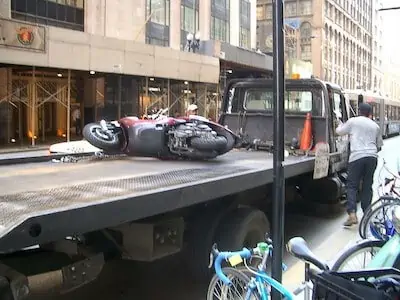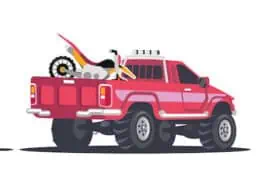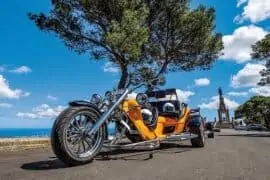The national towing motorcycle cost average for bikes requiring repair is approximately $100, although charges can be $400 or more. Several variables play into this cost, including the make and model’s weight, the distance it needs to travel, and if any specific equipment is necessary to complete the work.
If you need to tow a motorcycle over a long distance, the cost can be as much as $4 per mile. A hook-up fee is usually included, which can be anywhere from $50 to $250 for the average provider.
Didn't You Try Our Quote Comparison Tool Yet? Save BIG by Doing it!
Breakdown of Motorcycle Towing Charges
Although every provider differs, you can expect similar charges for motorcycle towing services across the United States. Most companies bill by mile or set specific rates for distances, such as paying $100 to cover the first 50 miles.
Here is a closer look at what to expect if you have a bike that needs to get towed.
Unless you have a local tow to manage, most providers charge by the mile for these services. A hook-up fee is typically included because of the mileage required to reach your motorcycle’s location.
One of the best ways to avoid this unexpected expense is to include emergency roadside assistance services with your motorcycle insurance policy. Other providers, such as AAA, provide add-on products with similar outcomes when purchasing a membership.
Insurance companies like GEICO and Progressive charge about $20 per year to add motorcycle towing coverage to a policy. You might need to purchase a membership package at AAA, ranging from $65 to over $100 annually.
It is usually cheaper to include towing services with motorcycle insurance. The cost difference can be more than $150 per year, especially if you only support for 50 miles or less.
Long-distance hauling is not the same as towing. If you’re transporting your motorcycle to a new address without a repair required, these cost breakdowns won’t apply to your situation.
I’ve only had to deal with a motorcycle tow once, but I was grateful to have roadside assistance coverage that helped me in that situation. I highly recommend it to all riders.
What Is the Cheapest Way to Tow a Motorcycle?
Motorcycle towing insurance is the cheapest option to use in most circumstances. Three methods are typically used to safely and securely tow a bike.
- Cradles and Dollies
- Flatbed Towing
- Two-Wheel Towing
The most popular choice is flatbed towing because the motorcycle doesn’t need to be operational to use this method. Straps, ropes, and locks secure the bike to the vehicle. It’s usually the cheapest professional option available.
If you want to do the towing work yourself, a tow dolly is an affordable way to move your motorcycle. It is like the flatbed method, but the trailer has a specific area for the front tire to make things more secure. You’ll need a vehicle with a hitch to use this option.
If you want to take the help of your car, here is a guide for you.
When a motorcycle needs a checkup or decides to stop working, towing it to a trusted mechanic makes sense. Knowing what you’ll pay for that service makes it easier to understand what your budget needs are in that situation.
How to Tow a Motorcycle by Yourself
Towing a motorcycle alone can be challenging and potentially dangerous if not done correctly. If you don’t have anyone to help, these steps can help you have a safe experience.
- You’ll need a reliable tow strap or a dolly that can safely support the weight of your motorcycle. A flatbed trailer is the best option if available.
- Attach the tow strap to the motorcycle’s frame, preferably to the triple tree or the handlebar clamps, and not to the bodywork, footpegs, or other non-structural components. Ensure it is tightly secured and won’t come loose during towing.
- Ensure that the motorcycle’s brakes are functioning correctly before towing. If the bike cannot be started, then ensure the brakes are locked to prevent the wheels from rolling during the tow.
- When towing the motorcycle, drive slowly and cautiously, and avoid sudden acceleration, deceleration, or sharp turns. Keep safe from other vehicles and be cautious when going over bumps or rough terrain.
- Stop periodically to check the straps to ensure the motorcycle hasn’t come loose or shifted.
- When you reach your destination, carefully unload the motorcycle, ensuring it’s stable before removing the tow strap.
Towing a bike does come with a cost, even if you do most or all the work yourself. With roadside assistance included with your motorcycle insurance, you can limit or eliminate this unexpected cost while exploring the open road.
Use This Tool for Free and Save on Quotes!






